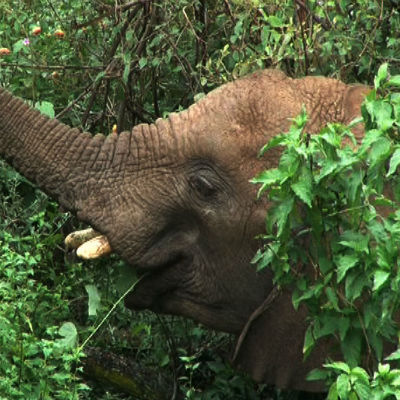Elephants on the edge
ELEPHANTS ON THE EDGE
AS PART OF OUR ELEPHANTS IN CRISIS CAMPAIGN, BORN FREE’S HEAD OF CONSERVATION DR LIZ GREENGRASS EXPLAINS WHY, UNLIKE THEIR COUNTERPARTS IN AMBOSELI, ELEPHANTS IN ETHIOPIA AND CAMEROON HAVE DEVELOPED AN ELE-ARROGANCE TO PERSEVERE
Amboseli is a lush green mega-swamp, an everglade and mire fed by the cold mountain rivers of Kilimanjaro. In the soft molten light unique to this site, elephant wade knee-deep in swamp water, foraging quietly, ears flapping intermittently, and even from a high point, as tiny dots below, with the land rolled out like a velveteen carpet, they meander and tower above everything else.
Close up and dwarfed, baby elephants run comically among the herd, their tiny trunks flapping redundantly, while their mothers use their own to caress and guide; the trunk is a tactile appendage, touch one of the most important senses. Young lone bulls nonchalantly wander around parked vehicles with a Clint Eastwood demeanour, watchful through a curtain of thick girlish eyelashes, surely conscious of the awe they inspire in their human audience. Young bulls are kept in check, occasionally reprimanded for disobedience and mischief by the older ones, some of whom revel in the role of mentor and coach. From their comportment, there is little to fear. On this plain they are kings.
At Babile, Ethiopia, the air is parched and the dry brown and greens of the prickly vegetation roll out to meet the never-ending azure of the sky. Here, the elephants – reddish from the dust they’ve covered themselves in – move in one large nervous herd. The air is pungent with their smell; skittish, their trunks waver in the air.

In Cameroon, forest elephants haunt a pillaged forest. Like ghosts they are rarely seen and barely heard. Beneath the annual fall of leaves, their pathways – once wide and worn – are fading fast. Muddy wallows and markets stand vacant. Moving within the shade and shadow, we note their tenuous presence only from the trail of prints and dung they leave behind.
Between 2007 and 2014, poaching had driven a 30% decline in the savannah elephant. By the end of the first decade of this millennium we’d lost over 60% of their forest cousins. That great swath of land called Congo in the heart of the African continent is now bereft of them. Their loss, as rapid and as silent as a pandemic, has been protected from scrutiny by the impenetrable nature of the Congo Basin, and the visibility of that other massacre out on the African plain. Tusks become bargaining chips and status symbols. Stockpiled and moved across the continent’s porous borders, they fund Africa’s lamentable wars; once shipped, they are conjured up into a work of art, a well-lit illusion in a display cabinet that hides that bloody past.
In Cameroon, we gain solace in finding the delicate prints of a baby elephant among those of a family herd. We do not know whether that baby will survive long enough to reach adulthood, but it is a sign of their intention to endure, and a kind of ele-arrogance to persevere, which marks the spirit of the natural world we are always trying to destroy.
VIDEO: MONITORING FOREST ELEPHANTS IN CAMEROON ELEPHANTS IN CRISIS
